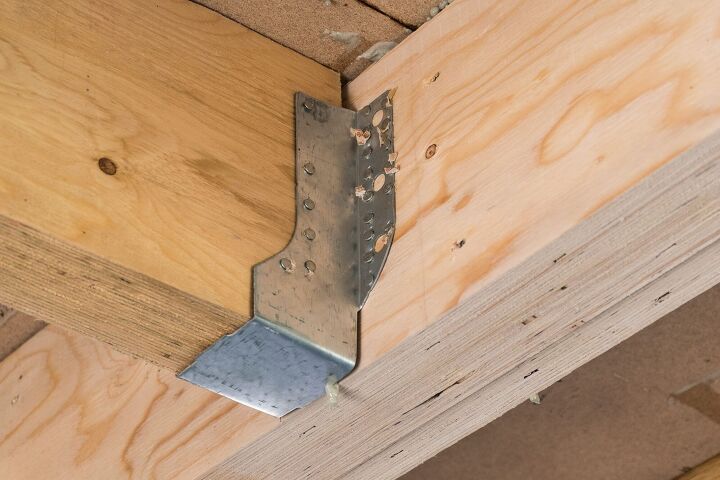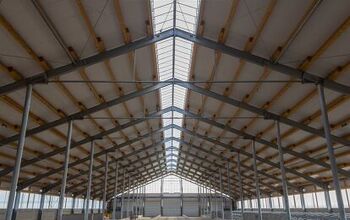Can Screws Be Used With Joist Hangers Instead Of Nails?

If you are building a structure that requires some support beams and additional safety measures, you might have purchased some joist hangers. Joist hangers are very strong pieces of hardware that offer additional weight support and security for weight bearing structures. They are much stronger than just using nails or screws alone. As you prepare to install your joist hangers, you might wonder if you can use screws instead of nails to install them.
You should only use screws instead of nails for joist hangers when they are provided by the manufacturer along with the joist hanger themselves. Never use deck screws or drywall screws to secure your joist fasteners, as joist hangers are engineered products that require specific hardware. If your joist fasteners come with manufacturer provided nails, use them. Failure to install joist hangers properly can result in a hazardous result.
If you are not sure how exactly to install your joist hangers and what to use, don’t worry, we are here to help. Joist hangers might be small, and installing them poorly can have devastating consequences. This type of installation is not something you should rush or perform without research. So, first things first; you should understand what joist hangers are and why they are so crucial to some building projects.
What Are Joist Hangers And Why Are They Important?
Joist hangers are common hardware pieces used in many building and construction projects. In particular, they are used in wood buildings when beams need support. They are metal (usually galvanized) hangers that have a U-shape appearance.
The idea is that a specific-sized piece of lumber is to snugly fit inside that U-shape. Then multiple nails are used to secure it to both the joist hanger and the other piece of material the joist hanger is connected to. This is why you so commonly see joist hangers with support beams and other such structures.
Joist hangers are important because they are load-bearing pieces of hardware. They are installed because they are much safer and stronger than simply using nails or screws. When you install joist hangers, it is critical to take precautions and use only the correct materials.
Can You Use Screws Instead Of Nails For Joist Hangers?
You might have joist hangers that came with nails. In fact, they often do. This might have you wondering if maybe using some screws instead of nails will be easier and more secure. But the truth is, it is rarely a good idea to use screws instead of nails when installing joist hangers.
In fact, the only time you should use screws instead of nails for your joist hangers is when screws come with the joist hangers from the manufacturer. This is because joist hangers are specifically engineered products. There should be no deviance from the manufacturer’s design and intentions. To put it simply, unless your joist hangers came with screws, you shouldn’t use screws to install them.
Types Of Screws You Should Never Use With Joist Hangers
In general, it is best not to use screws with joist hangers unless specifically instructed, or if they come in the pack with the hangers. Other than these circumstances, it is best to stick with the provided nails, and perhaps even stronger (galvanized) nails when the situation calls for it.
There are, however, some screws that you should never use in these circumstances. Standard wood screws, drywall screws and deck screws should never be used when installing joist hangers. They are likely not equipped to hold this amount of weight for several reasons.
Even though you may have a lot of these screws laying around the garage, don’t be tempted to use them in a pinch. Always refer to your installation instructions and the manufacturer. This ensures you are using the right hardware to install these critical home building elements.
Reasons Why You Should Not Use Screws For Joist Hangers
Now that you know it is best to use nails, unless screws are provided, you might wonder why. If you still are on the fence or skeptical, we have listed several reasons why you shouldn’t use any old screw for your joist hangers.
If They Aren’t Supplied From The Manufacturer, Don’t Use Them
While we have made this clear earlier, it is important to remember this is a universal rule. You shouldn’t swap out screws for nails and nails for screws unless it is an improvement. In this case, however, making the wrong swap can have hazardous and even deadly consequences.
Not Up To Code
Improperly installing joist hangers can lead to all sorts of issues. Additionally, using the wrong materials can cause the structure to not be up to code. This can lead to potential legal issues down the road. It can also cause you to have to repeat work at a later date. Never cut corners or swap out materials unless you are certain it is approved by local building codes.
Might Not Be Strong Enough
Most importantly, the screws you use might work for their intended purposes, but they might not be strong enough for the joist hangers. Some wood screws are fantastic at combining and securing wood. This does not, however, mean they can help support the weight of up to 800 pounds. Different screws and nails have unique strengths and weaknesses. They are not always obvious either.
Joist Hangers Are Load-Bearing
Joist hangers are often load-bearing pieces of hardware. And in most cases, we aren’t talking about picture frames or 20-pound pieces of wood. These hangers help support upward of 200 to 1,000 pounds or more. In these circumstances, there needs to be a particular level of care and precision.
Screws Are Not Always Stronger Than Nails
It is a common misconception that screws are always stronger than nails. In most cases, it is true that screws offer more tensile strength than nails of the same size. But overall, nails tend to have the greater sheer strength. Regardless of the overall strength, remember that the nail or screw chosen for the specific joist hanger was done so with thought and intent.
Four Common Errors To Avoid When You Install Joist Hangers
1. The wrong kind of joist hangers are used
Using screws, or the wrong screws, is not the only mistake people make when installing joist hangers. In fact, it is common to pick out the wrong joist hangers altogether. Joist hangers come in all shapes and sizes. They support beams at different angles, and beams of different sizes.
Make sure you purchase the correct joist hangers for the job you are doing. Selecting the wrong ones can lead to loose or poor connections, and compromised stability.
2. The Wrong Nail Or Screws Are Used
As we mentioned earlier, it is never a good idea to use the wrong nail or screw. These should never be swapped out without careful research and thought. Still, using the wrong nail or screw for joist hangers is a common error. Only use the nails or screws that are provided by the manufacturer. If for some reason there are no nails or screws, research the specific nails (or screws) that go with the joist hanger in questions. Never guess, and never substitute.
3. Not Filling Nail Holes
Another problem involves a lack of effort. In some cases, the person installing the joist hangers doesn’t fill all the nail holes. If the joist hanger has three nail holes, for example, filling only two of the holes means the job is incomplete. This leaves the joist hangers vulnerable.
Just as it is critical to use the right nails (or screws) when installing joist hangers, it is equally important to use the correct amount. Don’t cut corners, ever, when it comes to installing joist hangers.
4. You Didn’t Use Enough Joist Hangers
In addition to not using enough nails, it is also possible to not use enough joist hangers. Joist hangers should help share the load. But in order for them to work best, you need to use the correct amount. Make sure you are using joist hangers in all recommended areas to help strengthen all necessary connections, and lessen the pressure overall.
Summarizing If You Can Use Screws With Joist Hangers
As you begin your construction project with joist hangers, make sure you have all the proper materials. This includes the correct nails to install the joist hangers. You might wonder if you can use screws instead of the provided nails. The only time you should use screws to install joist hangers is if they were provided by the joist hanger manufacturer for that purpose. Otherwise, use the correct nails provided.
Failure to do so can result in all sorts of issues, several of which are dangerous. In no circumstances should you use deck screws, drywall screws or regular wood screws instead of the provided nails. Joist hangers are load bearing pieces of hardware. Install them with care and accuracy.
Related Guides:

Tom Gaffey is an expert writer who currently resides in Washington D.C. Tom has a passion for real estate and home improvement writing, as well as travel and lifestyle writing. He lived the last twelve years in Hawaii where he worked closely with luxury resorts and event planners, mastering his knowledge of aesthetics and luxury products. This is where he found his passion for home improvement and a keen interest in DIY projects. Currently, Tom resides in Washington D.C, and also working on his debut fiction novel.
More by Tom Gaffey












![Finishing Basement Without Permit [Is It Really Illegal?]](https://cdn-fastly.upgradedhome.com/media/2023/07/31/9070078/finishing-basement-without-permit-is-it-really-illegal.jpg?size=350x220)














